
- •About the author
- •Brief Contents
- •Contents
- •Preface
- •This Book’s Approach
- •What’s New in the Seventh Edition?
- •The Arrangement of Topics
- •Part One, Introduction
- •Part Two, Classical Theory: The Economy in the Long Run
- •Part Three, Growth Theory: The Economy in the Very Long Run
- •Part Four, Business Cycle Theory: The Economy in the Short Run
- •Part Five, Macroeconomic Policy Debates
- •Part Six, More on the Microeconomics Behind Macroeconomics
- •Epilogue
- •Alternative Routes Through the Text
- •Learning Tools
- •Case Studies
- •FYI Boxes
- •Graphs
- •Mathematical Notes
- •Chapter Summaries
- •Key Concepts
- •Questions for Review
- •Problems and Applications
- •Chapter Appendices
- •Glossary
- •Translations
- •Acknowledgments
- •Supplements and Media
- •For Instructors
- •Instructor’s Resources
- •Solutions Manual
- •Test Bank
- •PowerPoint Slides
- •For Students
- •Student Guide and Workbook
- •Online Offerings
- •EconPortal, Available Spring 2010
- •eBook
- •WebCT
- •BlackBoard
- •Additional Offerings
- •i-clicker
- •The Wall Street Journal Edition
- •Financial Times Edition
- •Dismal Scientist
- •1-1: What Macroeconomists Study
- •1-2: How Economists Think
- •Theory as Model Building
- •The Use of Multiple Models
- •Prices: Flexible Versus Sticky
- •Microeconomic Thinking and Macroeconomic Models
- •1-3: How This Book Proceeds
- •Income, Expenditure, and the Circular Flow
- •Rules for Computing GDP
- •Real GDP Versus Nominal GDP
- •The GDP Deflator
- •Chain-Weighted Measures of Real GDP
- •The Components of Expenditure
- •Other Measures of Income
- •Seasonal Adjustment
- •The Price of a Basket of Goods
- •The CPI Versus the GDP Deflator
- •The Household Survey
- •The Establishment Survey
- •The Factors of Production
- •The Production Function
- •The Supply of Goods and Services
- •3-2: How Is National Income Distributed to the Factors of Production?
- •Factor Prices
- •The Decisions Facing the Competitive Firm
- •The Firm’s Demand for Factors
- •The Division of National Income
- •The Cobb–Douglas Production Function
- •Consumption
- •Investment
- •Government Purchases
- •Changes in Saving: The Effects of Fiscal Policy
- •Changes in Investment Demand
- •3-5: Conclusion
- •4-1: What Is Money?
- •The Functions of Money
- •The Types of Money
- •The Development of Fiat Money
- •How the Quantity of Money Is Controlled
- •How the Quantity of Money Is Measured
- •4-2: The Quantity Theory of Money
- •Transactions and the Quantity Equation
- •From Transactions to Income
- •The Assumption of Constant Velocity
- •Money, Prices, and Inflation
- •4-4: Inflation and Interest Rates
- •Two Interest Rates: Real and Nominal
- •The Fisher Effect
- •Two Real Interest Rates: Ex Ante and Ex Post
- •The Cost of Holding Money
- •Future Money and Current Prices
- •4-6: The Social Costs of Inflation
- •The Layman’s View and the Classical Response
- •The Costs of Expected Inflation
- •The Costs of Unexpected Inflation
- •One Benefit of Inflation
- •4-7: Hyperinflation
- •The Costs of Hyperinflation
- •The Causes of Hyperinflation
- •4-8: Conclusion: The Classical Dichotomy
- •The Role of Net Exports
- •International Capital Flows and the Trade Balance
- •International Flows of Goods and Capital: An Example
- •Capital Mobility and the World Interest Rate
- •Why Assume a Small Open Economy?
- •The Model
- •How Policies Influence the Trade Balance
- •Evaluating Economic Policy
- •Nominal and Real Exchange Rates
- •The Real Exchange Rate and the Trade Balance
- •The Determinants of the Real Exchange Rate
- •How Policies Influence the Real Exchange Rate
- •The Effects of Trade Policies
- •The Special Case of Purchasing-Power Parity
- •Net Capital Outflow
- •The Model
- •Policies in the Large Open Economy
- •Conclusion
- •Causes of Frictional Unemployment
- •Public Policy and Frictional Unemployment
- •Minimum-Wage Laws
- •Unions and Collective Bargaining
- •Efficiency Wages
- •The Duration of Unemployment
- •Trends in Unemployment
- •Transitions Into and Out of the Labor Force
- •6-5: Labor-Market Experience: Europe
- •The Rise in European Unemployment
- •Unemployment Variation Within Europe
- •The Rise of European Leisure
- •6-6: Conclusion
- •7-1: The Accumulation of Capital
- •The Supply and Demand for Goods
- •Growth in the Capital Stock and the Steady State
- •Approaching the Steady State: A Numerical Example
- •How Saving Affects Growth
- •7-2: The Golden Rule Level of Capital
- •Comparing Steady States
- •The Transition to the Golden Rule Steady State
- •7-3: Population Growth
- •The Steady State With Population Growth
- •The Effects of Population Growth
- •Alternative Perspectives on Population Growth
- •7-4: Conclusion
- •The Efficiency of Labor
- •The Steady State With Technological Progress
- •The Effects of Technological Progress
- •Balanced Growth
- •Convergence
- •Factor Accumulation Versus Production Efficiency
- •8-3: Policies to Promote Growth
- •Evaluating the Rate of Saving
- •Changing the Rate of Saving
- •Allocating the Economy’s Investment
- •Establishing the Right Institutions
- •Encouraging Technological Progress
- •The Basic Model
- •A Two-Sector Model
- •The Microeconomics of Research and Development
- •The Process of Creative Destruction
- •8-5: Conclusion
- •Increases in the Factors of Production
- •Technological Progress
- •The Sources of Growth in the United States
- •The Solow Residual in the Short Run
- •9-1: The Facts About the Business Cycle
- •GDP and Its Components
- •Unemployment and Okun’s Law
- •Leading Economic Indicators
- •9-2: Time Horizons in Macroeconomics
- •How the Short Run and Long Run Differ
- •9-3: Aggregate Demand
- •The Quantity Equation as Aggregate Demand
- •Why the Aggregate Demand Curve Slopes Downward
- •Shifts in the Aggregate Demand Curve
- •9-4: Aggregate Supply
- •The Long Run: The Vertical Aggregate Supply Curve
- •From the Short Run to the Long Run
- •9-5: Stabilization Policy
- •Shocks to Aggregate Demand
- •Shocks to Aggregate Supply
- •10-1: The Goods Market and the IS Curve
- •The Keynesian Cross
- •The Interest Rate, Investment, and the IS Curve
- •How Fiscal Policy Shifts the IS Curve
- •10-2: The Money Market and the LM Curve
- •The Theory of Liquidity Preference
- •Income, Money Demand, and the LM Curve
- •How Monetary Policy Shifts the LM Curve
- •Shocks in the IS–LM Model
- •From the IS–LM Model to the Aggregate Demand Curve
- •The IS–LM Model in the Short Run and Long Run
- •11-3: The Great Depression
- •The Spending Hypothesis: Shocks to the IS Curve
- •The Money Hypothesis: A Shock to the LM Curve
- •Could the Depression Happen Again?
- •11-4: Conclusion
- •12-1: The Mundell–Fleming Model
- •The Goods Market and the IS* Curve
- •The Money Market and the LM* Curve
- •Putting the Pieces Together
- •Fiscal Policy
- •Monetary Policy
- •Trade Policy
- •How a Fixed-Exchange-Rate System Works
- •Fiscal Policy
- •Monetary Policy
- •Trade Policy
- •Policy in the Mundell–Fleming Model: A Summary
- •12-4: Interest Rate Differentials
- •Country Risk and Exchange-Rate Expectations
- •Differentials in the Mundell–Fleming Model
- •Pros and Cons of Different Exchange-Rate Systems
- •The Impossible Trinity
- •12-6: From the Short Run to the Long Run: The Mundell–Fleming Model With a Changing Price Level
- •12-7: A Concluding Reminder
- •Fiscal Policy
- •Monetary Policy
- •A Rule of Thumb
- •The Sticky-Price Model
- •Implications
- •Adaptive Expectations and Inflation Inertia
- •Two Causes of Rising and Falling Inflation
- •Disinflation and the Sacrifice Ratio
- •13-3: Conclusion
- •14-1: Elements of the Model
- •Output: The Demand for Goods and Services
- •The Real Interest Rate: The Fisher Equation
- •Inflation: The Phillips Curve
- •Expected Inflation: Adaptive Expectations
- •The Nominal Interest Rate: The Monetary-Policy Rule
- •14-2: Solving the Model
- •The Long-Run Equilibrium
- •The Dynamic Aggregate Supply Curve
- •The Dynamic Aggregate Demand Curve
- •The Short-Run Equilibrium
- •14-3: Using the Model
- •Long-Run Growth
- •A Shock to Aggregate Supply
- •A Shock to Aggregate Demand
- •A Shift in Monetary Policy
- •The Taylor Principle
- •14-5: Conclusion: Toward DSGE Models
- •15-1: Should Policy Be Active or Passive?
- •Lags in the Implementation and Effects of Policies
- •The Difficult Job of Economic Forecasting
- •Ignorance, Expectations, and the Lucas Critique
- •The Historical Record
- •Distrust of Policymakers and the Political Process
- •The Time Inconsistency of Discretionary Policy
- •Rules for Monetary Policy
- •16-1: The Size of the Government Debt
- •16-2: Problems in Measurement
- •Measurement Problem 1: Inflation
- •Measurement Problem 2: Capital Assets
- •Measurement Problem 3: Uncounted Liabilities
- •Measurement Problem 4: The Business Cycle
- •Summing Up
- •The Basic Logic of Ricardian Equivalence
- •Consumers and Future Taxes
- •Making a Choice
- •16-5: Other Perspectives on Government Debt
- •Balanced Budgets Versus Optimal Fiscal Policy
- •Fiscal Effects on Monetary Policy
- •Debt and the Political Process
- •International Dimensions
- •16-6: Conclusion
- •Keynes’s Conjectures
- •The Early Empirical Successes
- •The Intertemporal Budget Constraint
- •Consumer Preferences
- •Optimization
- •How Changes in Income Affect Consumption
- •Constraints on Borrowing
- •The Hypothesis
- •Implications
- •The Hypothesis
- •Implications
- •The Hypothesis
- •Implications
- •17-7: Conclusion
- •18-1: Business Fixed Investment
- •The Rental Price of Capital
- •The Cost of Capital
- •The Determinants of Investment
- •Taxes and Investment
- •The Stock Market and Tobin’s q
- •Financing Constraints
- •Banking Crises and Credit Crunches
- •18-2: Residential Investment
- •The Stock Equilibrium and the Flow Supply
- •Changes in Housing Demand
- •18-3: Inventory Investment
- •Reasons for Holding Inventories
- •18-4: Conclusion
- •19-1: Money Supply
- •100-Percent-Reserve Banking
- •Fractional-Reserve Banking
- •A Model of the Money Supply
- •The Three Instruments of Monetary Policy
- •Bank Capital, Leverage, and Capital Requirements
- •19-2: Money Demand
- •Portfolio Theories of Money Demand
- •Transactions Theories of Money Demand
- •The Baumol–Tobin Model of Cash Management
- •19-3 Conclusion
- •Lesson 2: In the short run, aggregate demand influences the amount of goods and services that a country produces.
- •Question 1: How should policymakers try to promote growth in the economy’s natural level of output?
- •Question 2: Should policymakers try to stabilize the economy?
- •Question 3: How costly is inflation, and how costly is reducing inflation?
- •Question 4: How big a problem are government budget deficits?
- •Conclusion
- •Glossary
- •Index
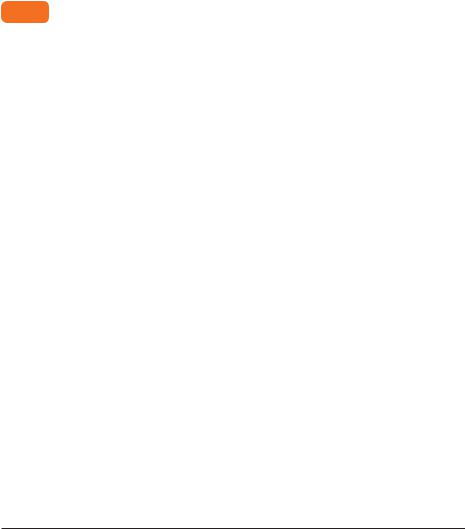
C H A P T E R 1 0 Aggregate Demand I: Building the IS–LM Model | 289
The two parts of the IS –LM model are, not surprisingly, the IS curve and the LM curve. IS stands for “investment’’ and “saving,’’ and the IS curve represents what’s going on in the market for goods and services (which we first discussed in Chapter 3). LM stands for “liquidity’’ and “money,’’ and the LM curve represents what’s happening to the supply and demand for money (which we first discussed in Chapter 4). Because the interest rate influences both investment and money demand, it is the variable that links the two halves of the IS –LM model. The model shows how interactions between the goods and money markets determine the position and slope of the aggregate demand curve and, therefore, the level of national income in the short run.1
10-1 The Goods Market and the IS Curve
The IS curve plots the relationship between the interest rate and the level of income that arises in the market for goods and services. To develop this relationship, we start with a basic model called the Keynesian cross. This model is the simplest interpretation of Keynes’s theory of how national income is determined and is a building block for the more complex and realistic IS–LM model.
The Keynesian Cross
In The General Theory Keynes proposed that an economy’s total income was, in the short run, determined largely by the spending plans of households, businesses, and government. The more people want to spend, the more goods and services firms can sell. The more firms can sell, the more output they will choose to produce and the more workers they will choose to hire. Keynes believed that the problem during recessions and depressions was inadequate spending. The Keynesian cross is an attempt to model this insight.
Planned Expenditure We begin our derivation of the Keynesian cross by drawing a distinction between actual and planned expenditure. Actual expenditure is the amount households, firms, and the government spend on goods and services, and as we first saw in Chapter 2, it equals the economy’s gross domestic product (GDP). Planned expenditure is the amount households, firms, and the government would like to spend on goods and services.
Why would actual expenditure ever differ from planned expenditure? The answer is that firms might engage in unplanned inventory investment because their sales do not meet their expectations. When firms sell less of their product than they planned, their stock of inventories automatically rises; conversely, when
1 The IS-LM model was introduced in a classic article by the Nobel Prize–winning economist John R. Hicks, “Mr. Keynes and the Classics: A Suggested Interpretation,’’ Econometrica 5 (1937): 147–159.

290 | P A R T I V Business Cycle Theory: The Economy in the Short Run
firms sell more than planned, their stock of inventories falls. Because these unplanned changes in inventory are counted as investment spending by firms, actual expenditure can be either above or below planned expenditure.
Now consider the determinants of planned expenditure. Assuming that the economy is closed, so that net exports are zero, we write planned expenditure PE as the sum of consumption C, planned investment I, and government purchases G:
PE = C + I + G.
To this equation, we add the consumption function
C = C(Y − T ).
This equation states that consumption depends on disposable income (Y − T ), which is total income Y minus taxes T. To keep things simple, for now we take planned investment as exogenously fixed:
I = I−.
Finally, as in Chapter 3, we assume that fiscal policy—the levels of government purchases and taxes—is fixed:
= −
G G ,
= −
T T .
Combining these five equations, we obtain
= − − − −
PE C(Y T ) + I + G .
This equation shows that planned expenditure is a function of income Y, the |
||
− |
− |
− |
level of planned investment I , and the fiscal policy variables G and T .
Figure 10-2 graphs planned expenditure as a function of the level of income. This line slopes upward because higher income leads to higher consumption and
FIGURE 10-2
Planned |
|
expenditure, PE |
Planned expenditure, PE C(Y T) I G |
MPC
$1
Planned Expenditure as a Function of Income Planned expenditure PE depends on income because higher income leads to higher consumption, which is part of planned expenditure. The slope of the planned-expenditure function is the marginal propensity to consume, MPC.
Income, output, Y
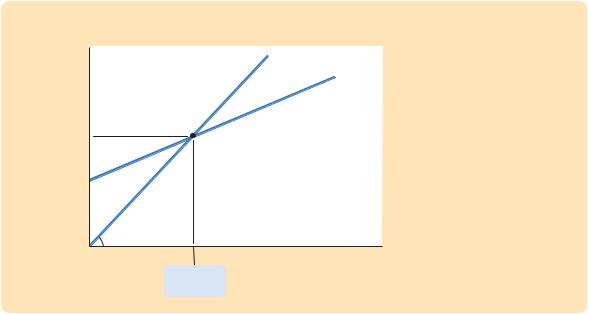
C H A P T E R 1 0 Aggregate Demand I: Building the IS–LM Model | 291
thus higher planned expenditure. The slope of this line is the marginal propensity to consume, MPC: it shows how much planned expenditure increases when income rises by $1. This planned-expenditure function is the first piece of the model called the Keynesian cross.
The Economy in Equilibrium The next piece of the Keynesian cross is the assumption that the economy is in equilibrium when actual expenditure equals planned expenditure. This assumption is based on the idea that when people’s plans have been realized, they have no reason to change what they are doing. Recalling that Y as GDP equals not only total income but also total actual expenditure on goods and services, we can write this equilibrium condition as
Actual Expenditure = Planned Expenditure
Y = PE.
The 45-degree line in Figure 10-3 plots the points where this condition holds. With the addition of the planned-expenditure function, this diagram becomes the Keynesian cross. The equilibrium of this economy is at point A, where the planned-expenditure function crosses the 45-degree line.
How does the economy get to equilibrium? In this model, inventories play an important role in the adjustment process. Whenever an economy is not in equilibrium, firms experience unplanned changes in inventories, and this induces them to change production levels. Changes in production in turn influence total income and expenditure, moving the economy toward equilibrium.
For example, suppose the economy finds itself with GDP at a level greater than the equilibrium level, such as the level Y1 in Figure 10-4. In this case, planned expenditure PE1 is less than production Y1, so firms are selling less than
FIGURE 10-3 |
|
|
Expenditure |
Actual expenditure, |
|
(Planned, PE |
||
Y PE |
||
Actual, Y) |
||
|
||
|
G |
The Keynesian Cross The equilibrium in the Keynesian cross is the point at which income (actual expenditure) equals planned expenditure (point A).
Income, output, Y
Equilibrium income
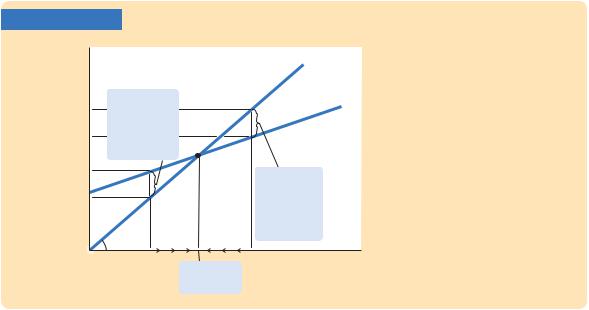
292 | P A R T I V Business Cycle Theory: The Economy in the Short Run
FIGURE 10-4 |
|
|
|
Expenditure |
|
|
Actual expenditure |
(Planned, PE, |
|
|
|
|
|
|
|
Actual, Y) |
|
|
|
Y1 |
Unplanned |
|
|
drop in |
|
|
|
|
|
|
|
PE1 |
inventory |
|
Planned expenditure |
causes |
|
||
|
income to rise. |
|
|
PE2 |
|
|
Unplanned |
|
|
|
|
Y2 |
|
|
inventory |
|
|
accumulation |
|
|
|
|
|
|
|
|
causes |
|
45º |
|
income to fall. |
|
|
|
|
|
Y2 |
Y1 |
Income, output, Y |
|
|
Equilibrium |
|
|
|
income |
|
The Adjustment to Equilibrium in the Keynesian Cross If firms are producing at level Y1, then planned expenditure PE1 falls short of production, and firms accumulate inventories. This inventory accumulation induces firms to decrease production. Similarly, if
firms are producing at level Y2, then planned expenditure PE2 exceeds production, and firms run down their inventories. This fall in inventories induces firms to increase production. In both cases, the firms’ decisions drive the economy toward equilibrium.
they are producing. Firms add the unsold goods to their stock of inventories. This unplanned rise in inventories induces firms to lay off workers and reduce production; these actions in turn reduce GDP. This process of unintended inventory accumulation and falling income continues until income Y falls to the equilibrium level.
Similarly, suppose GDP is at a level lower than the equilibrium level, such as the level Y2 in Figure 10-4. In this case, planned expenditure PE2 is greater than production Y2. Firms meet the high level of sales by drawing down their inventories. But when firms see their stock of inventories dwindle, they hire more workers and increase production. GDP rises, and the economy approaches the equilibrium.
In summary, the Keynesian cross shows how income Y is determined for given levels of planned investment I and fiscal policy G and T. We can use this model to show how income changes when one of these exogenous variables changes.
Fiscal Policy and the Multiplier: Government Purchases Consider how changes in government purchases affect the economy. Because government purchases are one component of expenditure, higher government purchases result in higher planned expenditure for any given level of income. If government purchases rise by G, then the planned-expenditure schedule shifts upward by G, as in Figure 10-5. The equilibrium of the economy moves from point A to point B.
This graph shows that an increase in government purchases leads to an even greater increase in income. That is, Y is larger than G. The ratio Y/ G is called the government-purchases multiplier; it tells us how much income rises in response to a $1 increase in government purchases. An implication of the Keynesian cross is that the government-purchases multiplier is larger than 1.
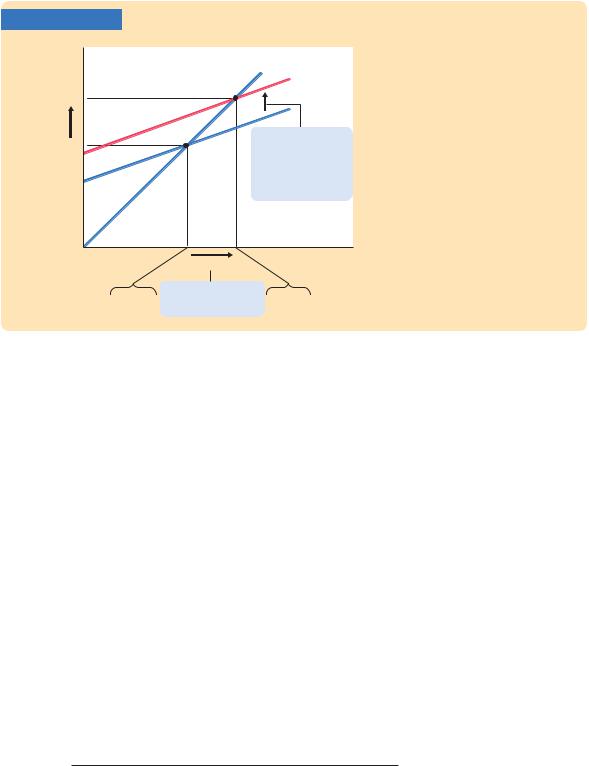
C H A P T E R 1 0 Aggregate Demand I: Building the IS–LM Model | 293
FIGURE 10-5
Expenditure
|
Actual expenditure |
|
|
B |
Planned |
|
expenditure |
|
PE2 Y2 |
|
G |
Y |
|
|
PE1 Y1 |
|
1. An increase |
A |
in government |
|
purchases shifts planned expenditure upward, ...
 45º
45º
Income, output, Y
Y
PE1 Y1 |
2. ...which increases |
PE2 |
Y2 |
|
equilibrium income. |
||||
|
|
|
An Increase in Government Purchases in the Keynesian Cross
An increase in government purchases of G raises planned expenditure by that amount for any given level of income. The equilibrium moves from point A to point B, and income rises from Y1 to Y2. Note that the increase in income Y exceeds the increase in government purchases G. Thus, fiscal policy has a multiplied effect on income.
Why does fiscal policy have a multiplied effect on income? The reason is that, according to the consumption function C = C(Y − T ), higher income causes higher consumption. When an increase in government purchases raises income, it also raises consumption, which further raises income, which further raises consumption, and so on. Therefore, in this model, an increase in government purchases causes a greater increase in income.
How big is the multiplier? To answer this question, we trace through each step of the change in income. The process begins when expenditure rises by G, which implies that income rises by G as well. This increase in income in turn raises consumption by MPC × G, where MPC is the marginal propensity to consume. This increase in consumption raises expenditure and income once again. This second increase in income of MPC × G again raises consumption, this time by MPC × (MPC × G ), which again raises expenditure and income, and so on. This feedback from consumption to income to consumption continues indefinitely. The total effect on income is
Initial Change in Government Purchases = |
|
DG |
|
First Change in Consumption |
= MPC × DG |
||
Second Change in Consumption |
= MPC2 |
× |
D |
G |
|||
. |
= MPC3 |
. |
D |
Third Change in Consumption |
× |
G |
|
. |
|
. |
|
. |
|
. |
|
DY = (1 + MPC + MPC2 + MPC3 + . . .)DG.

294 | P A R T I V Business Cycle Theory: The Economy in the Short Run
The government-purchases multiplier is
DY/DG = 1 + MPC + MPC2 + MPC3 + . . .
This expression for the multiplier is an example of an infinite geometric series. A result from algebra allows us to write the multiplier as2
DY/DG = 1/(1 − MPC ).
For example, if the marginal propensity to consume is 0.6, the multiplier is
DY/DG = 1 + 0.6 + 0.62 + 0.63 + . . .
= 1/(1 − 0.6)
= 2.5.
In this case, a $1.00 increase in government purchases raises equilibrium income by $2.50.3
Fiscal Policy and the Multiplier: Taxes Consider now how changes in taxes affect equilibrium income. A decrease in taxes of T immediately raises disposable income Y − T by T and, therefore, increases consumption by MPC × T. For any given level of income Y, planned expenditure is now higher. As Figure 10-6 shows, the planned-expenditure schedule shifts upward by MPC × T.
The equilibrium of the economy moves from point A to point B.
2 Mathematical note: We prove this algebraic result as follows. For x < 1, let z = 1 + x + x2 + . . . .
Multiply both sides of this equation by x:
xz = x + x2 + x3 + . . . .
Subtract the second equation from the first:
z − xz = 1.
Rearrange this last equation to obtain
z(1 − x) = 1,
which implies
z = 1/(1 − x).
This completes the proof.
3 Mathematical note: The government-purchases multiplier is most easily derived using a little calculus. Begin with the equation
Y = C(Y − T ) + I + G.
Holding T and I fixed, differentiate to obtain
dY = C′dY + dG,
and then rearrange to find
dY/dG = 1/(1 − C ′). This is the same as the equation in the text.
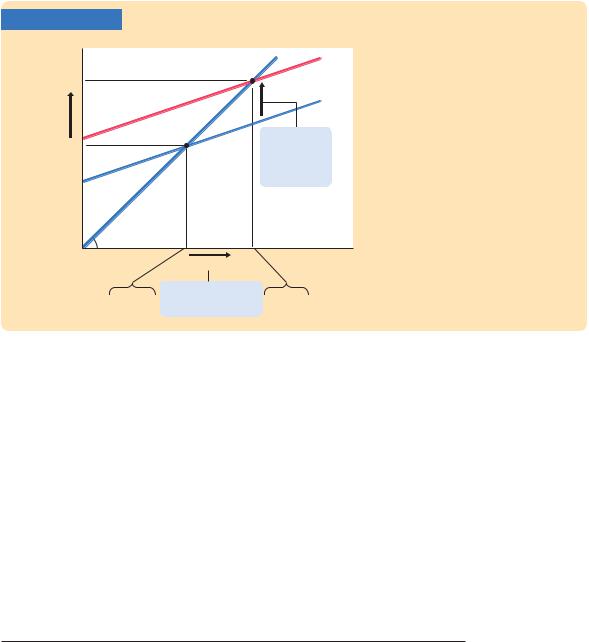
|
C H A P T E R |
1 0 Aggregate Demand I: Building the IS–LM Model | 295 |
|||
FIGURE 10-6 |
|
|
|
|
|
Expenditure |
Actual expenditure |
|
A Decrease in Taxes in the |
||
|
Planned |
Keynesian Cross A decrease in |
|||
PE2 Y2 |
B |
|
|||
|
|
expenditure |
taxes of T raises planned expendi- |
||
|
|
MPC |
T |
ture by MPC × |
T for any given |
Y |
|
|
|
level of income. The equilibrium |
|
|
|
|
moves from point A to point B, and |
||
|
|
|
|
||
PE1 Y1 |
|
1. A tax cut |
income rises from Y1 to Y2. Again, |
||
A |
shifts planned |
fiscal policy has a multiplied effect |
|||
|
expenditure |
on income. |
|
||
|
|
|
|||
|
|
upward, ... |
|
|
|
45º |
|
|
|
|
|
|
Y |
|
Income, |
|
|
|
|
output, Y |
|
|
|
|
|
|
|
|
|
2. ...which increases |
PE2 Y2 |
PE1 Y1 equilibrium income. |
Just as an increase in government purchases has a multiplied effect on income, so does a decrease in taxes. As before, the initial change in expenditure, now MPC × T, is multiplied by 1/(1 − MPC ). The overall effect on income of the change in taxes is
Y/ T = −MPC/(1 − MPC ).
This expression is the tax multiplier, the amount income changes in response to a $1 change in taxes. (The negative sign indicates that income moves in the opposite direction from taxes.) For example, if the marginal propensity to consume is 0.6, then the tax multiplier is
Y/ T = −0.6/(1 − 0.6) = −1.5.
In this example, a $1.00 cut in taxes raises equilibrium income by $1.50.4
4 Mathematical note: As before, the multiplier is most easily derived using a little calculus. Begin with the equation
Y = C(Y – T ) + I + G.
Holding I and G fixed, differentiate to obtain
dY = C ′(dY − dT ),
and then rearrange to find
dY/dT = –C ′/(1 − C ′). This is the same as the equation in the text.

296 | P A R T I V Business Cycle Theory: The Economy in the Short Run
CASE STUDY
Cutting Taxes to Stimulate the Economy:
The Kennedy and Bush Tax Cuts
When John F. Kennedy became president of the United States in 1961, he brought to Washington some of the brightest young economists of the day to work on his Council of Economic Advisers. These economists, who had been schooled in the economics of Keynes, brought Keynesian ideas to discussions of economic policy at the highest level.
One of the council’s first proposals was to expand national income by reducing taxes. This eventually led to a substantial cut in personal and corporate income taxes in 1964. The tax cut was intended to stimulate expenditure on consumption and investment and lead to higher levels of income and employment. When a reporter asked Kennedy why he advocated a tax cut, Kennedy replied,“To stimulate the economy. Don’t you remember your Economics 101?”
As Kennedy’s economic advisers predicted, the passage of the tax cut was followed by an economic boom. Growth in real GDP was 5.3 percent in 1964 and 6.0 percent in 1965. The unemployment rate fell from 5.7 percent in 1963 to 5.2 percent in 1964 and then to 4.5 percent in 1965.
Economists continue to debate the source of this rapid growth in the early 1960s. A group called supply-siders argues that the economic boom resulted from the incentive effects of the cut in income tax rates. According to supply-siders, when workers are allowed to keep a higher fraction of their earnings, they supply substantially more labor and expand the aggregate supply of goods and services. Keynesians, however, emphasize the impact of tax cuts on aggregate demand. Most likely, both views have some truth: Tax cuts stimulate aggregate supply by improving workers’ incentives and expand aggregate demand by raising households’ disposable income.
When George W. Bush was elected president in 2000, a major element of his platform was a cut in income taxes. Bush and his advisors used both supply-side and Keynesian rhetoric to make the case for their policy. (Full disclosure: The author of this textbook was one of Bush’s economic advisers from 2003 to 2005.) During the campaign, when the economy was doing fine, they argued that lower marginal tax rates would improve work incentives. But when the economy started to slow, and unemployment started to rise, the argument shifted to emphasize that the tax cut would stimulate spending and help the economy recover from the recession.
Congress passed major tax cuts in 2001 and 2003. After the second tax cut, the weak recovery from the 2001 recession turned into a robust one. Growth in real GDP was 4.4 percent in 2004. The unemployment rate fell from its peak of 6.3 percent in June 2003 to 5.4 percent in December 2004.
When President Bush signed the 2003 tax bill, he explained the measure using the logic of aggregate demand:“When people have more money, they can spend it on goods and services. And in our society, when they demand an additional good or a service, somebody will produce the good or a service. And when somebody produces that good or a service, it means somebody is more likely to be able to find a job.” The explanation could have come from an exam in Economics 101. ■
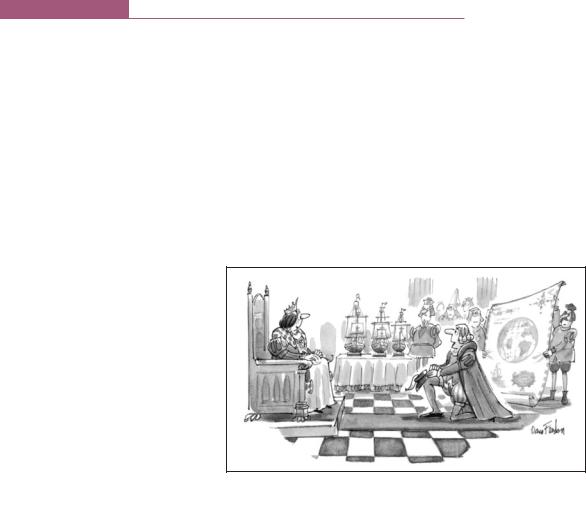
C H A P T E R 1 0 Aggregate Demand I: Building the IS–LM Model | 297
CASE STUDY
Increasing Government Purchases to Stimulate the Economy: The Obama Spending Plan
When President Barack Obama took office in January 2009, the economy was suffering from a significant recession. (The causes of this recession are discussed in a Case Study in the next chapter.) Even before he was inaugurated, the president and his advisers proposed a sizable stimulus package to increase aggregate demand. As proposed, the package would cost the federal government about $800 billion, or about 5 percent of annual GDP. The package included some tax cuts and higher transfer payments, but much of it was made up of increases in government purchases of goods and services.
Professional economists debated the merits of the plan. Advocates of the Obama plan argued that increased spending was better than reduced taxes because, accord-
ing to standard Keynesian theory, |
|
the government-purchases mul- |
|
tiplier exceeds the tax multipli- |
|
er. The reason for this difference |
Collection.YorkerNewThe© 1992 Dana Fradon cartoonbank.com.fromAll Rights Reserved. |
is simple: when the government |
|
ernment purchases multiplier is |
|
spends a dollar, that dollar gets |
|
spent, whereas when the gov- |
|
ernment gives households a tax |
|
cut of a dollar, some of that dol- |
|
lar might be saved. According |
|
to an analysis by Obama admin- |
|
istration economists, the gov- |
|
1.57, whereas the tax multiplier is only 0.99. Thus, they argued that increased government spend-
ing on roads, schools, and other infrastructure was the better route to increase aggregate demand and create jobs.
Other economists were more skeptical about the plan. One concern was that spending on infrastructure would take time, whereas tax cuts could occur more immediately. Infrastructure spending requires taking bids and signing contracts, and, even after the projects begin, they can take years to complete. The Congressional Budget Office estimated that only about 10 percent of the outlays would occur in the first nine months of 2009 and that a large fraction of outlays would be years away. By the time much of the stimulus went into effect, the recession might be well over.
In addition, some economists thought that using infrastructure spending to promote employment might conflict with the goal of obtaining the infrastructure that was most needed. Here is how Gary Becker, the Nobel Prize–winning economist, explained the concern on his blog:
Putting new infrastructure spending in depressed areas like Detroit might have a big stimulating effect since infrastructure building projects in these areas can utilize some of the considerable unemployed resources there. However, many of these
